Our Cemeteries Handbook contains conditions applying to activities and conduct in cemeteries within the Christchurch District and for the management of cemeteries owned by, or under the administration, of the Council.
Download a printable version of the Cemeteries Handbook and appendixes [PDF, 17 MB].
The handbook is to be used in conjunction with the Cemeteries Master Plan.
In compiling the Cemeteries Master Plan, Cemeteries Handbook and Cemeteries Bylaw 2013, the Councillors and staff of the Christchurch City Council have been very conscious that we are dealing with a deeply important and sensitive part of our community’s life.
How we care for our deceased loved ones is one of the most intimate and personal experiences for each of us. As a community, our cemeteries are an expression of the respect we show to those who have gone before.
They are to be places of contemplation, of serenity and prayer, of respect for our history and the stories of our people. They are places to come to grieve, to remember and to give thanks. Christchurch is made up of diverse communities of different cultures, faiths, ethnicities and values.
The Cemeteries Master Plan, Handbook and Bylaw are designed to enable us all to be as sensitive as we can be to our differences, while acknowledging that we are, at the end of the day, one people.
This Christchurch City Council Cemeteries Handbook contains regulations and information applying to activities and conduct and for the management of cemeteries owned by, or under the administration or management of the Christchurch City Council. It provides information to assist the smooth running, operation and provision of services in the cemeteries.
The Handbook is to be used in conjunction with the Christchurch City Council Cemeteries Master Plan.
The Master Plan Vision is to provide direction for the development and management of the cemeteries owned, managed or maintained by the Council for the next 50 years.
And, the natural, cultural, heritage, landscape and spiritual values are protected and enhanced by the integrated management of these areas as reserves and open spaces
While, māori values and traditions of their ancestral land, water, sites, waahi tapu, fauna and flora, and other taonga are protected and culture enhanced.
Open cemeteries
The open and currently operational cemeteries owned by, or under the administration or management of the Christchurch City Council include:
- Akaroa Anglican Cemetery
- Akaroa Catholic Cemetery
- Akaroa Dissenters Cemetery
- Avonhead Park Cemetery
- Belfast Cemetery
- Bromley Cemetery
- Diamond Harbour Memorial Gardens Cemetery
- Duvauchelle Cemetery
- Kaituna Valley Cemetery
- Le Bons Bay Cemetery
- Linwood Cemetery
- Little River Cemetery
- Lyttelton Anglican Cemetery
- Lyttelton Catholic and Public Cemetery
- Memorial Park Cemetery
- Pigeon Bay Cemetery
- Ruru Lawn Cemetery
- Sydenham Cemetery
- Waimairi Cemetery
- Wainui Cemetery
- Yaldhurst Cemetery.
For interments in these cemeteries contact the Christchurch City Council Cemeteries Team, phone 03 941 8646 Monday to Friday 8am to 4pm, or email cemeteries@ccc.govt.nz.
Closed cemeteries
The following cemeteries owned by, or under the administration or management of the Christchurch City
Council are closed and interments are no longer allowed:
- Addington Cemetery
- Akaroa French Cemetery
- Barbadoes Street Cemetery
- Mount Magdala Cemetery of the Good Shepherd Sisters and Rutherford Cemetery.
Refer to Appendix A [PDF, 17 MB] for the complete list of all Council-owned, administered or managed cemeteries.
Conditions
The conditions applying to cemeteries and activities in cemeteries contained in this Handbook were made in accordance with the Christchurch City Council Cemeteries Bylaw 2013 (the Bylaw) and legislation relevant to the activities in cemeteries, including the:
- Burial and Cremation Act 19641 and any amendments
- Burial and Cremation (Removal of Monuments and Tablets) Regulations 1967
- Christchurch City Council Dog Control Bylaw 2016
- Christchurch City Council Parks and Reserves Bylaw 2025
- Christchurch City Council Operational Pest Plan
- Property (Relationships) Act 1976
- Christchurch City Council Maintenance Contract for Urban Parks 2015
- Christchurch City Council Traffic and Parking Bylaw 2017
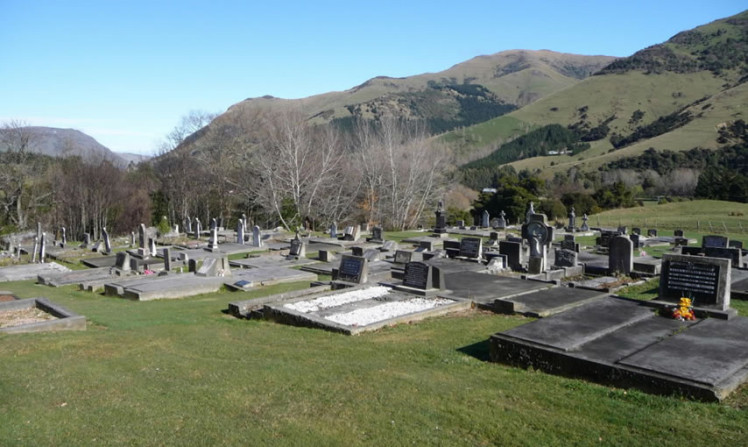
Little River Cemetery
| Approved Contractor for monumental work | A person approved by Council and responsible for the establishment, repair or modification of a monument. |
|---|---|
| Ash or ashes | Means the remains or ashes of the dead. |
| Burial or interment | The burial or depositing of a human body, or urn of ashes, in a plot or in a vault. |
| Cemetery | Land held, taken, purchased, acquired, dedicated or reserved under any statute, for the burial of the dead, and includes a closed cemetery. |
| Cemeteries team | The persons appointed by the Council to carry out administration work on behalf of the Council in relation to its cemeteries. |
| Concrete beam | Concrete span provided by Council in some cemeteries upon which monuments and tributes can be placed. |
| Cremated remains or ashes | The term used to describe the cremated remains of a human body or animal. |
| Disinterment | The removal of a human body or ash remains from the earth or any vault or the exhumation of a casket or urn of ashes from a plot or vault. |
| Embalm |
The treatment of a dead body with chemicals or oils to slow down the decaying process. |
| Exclusive right of burial |
The purchase of a right to burial in a particular cemetery plot. |
| Funeral director |
Means a person whose business is or includes disposing of bodies. |
| Green burial |
A burial that has a low environmental impact, including the body not being treated with chemicals or oils that prevent or slow down the decay of the body by bacteria. Green burial plots are planted but set out so long-term access to each plot will be possible. |
| Monument |
Includes any headstone, plaque, panel, memorial or concrete kerbing. |
| Natural burial |
A burial that has a low environmental impact, including the body not being treated with chemicals or oils that prevent or slow down the decay of the body by bacteria. Natural Burial areas are planted to encourage ecological restoration, long term individual plots may not be identifiable. |
| Plot or grave |
A numbered lot in a cemetery where burial or interment can occur. After a plot has been used it is often referred to as a grave. |
| Poor person |
A deceased person certified by a Justice of the Peace as being destitute, impoverished and having insufficient means to pay for funeral-related services, and the relatives and friends of the deceased person are also unable to pay these costs. |
| Pre-purchased plot |
A numbered lot in a cemetery purchased in advance for future use, generally as an Exclusive Right of Burial. |
| Representative |
Anyone who can satisfy the Council they have authority from the owner of the Exclusive Right of Burial and may include the immediate next of kin when the owner is deceased. |
| Sexton |
The person, and any assistant of that person, who is authorised by the Council to carry out work on behalf of the Council in any cemetery. No other person is authorised to prepare or fill a grave. |
| Standard sized urn |
Means an ashes urn measuring 270mm by 170mm. |
| Tributes or adornment | Items left at the plot or graveside as a tribute to the deceased such as floral arrangements, photos or other personal items. |
| Vault | A structure for the deposit of specially sealed coffins containing a human body, or containers of ashes. |
Opening hours
Cemeteries operated by the Council are open for public visiting seven days a week.
- Summer (daylight saving time) 7.00am to 8.00pm
- Winter (standard time) 8.00am to 5.00pm
Cemetery fees and forms
Cemetery fees are usually set by the Council annually and apply from the 1st July. All fees are available on the Council website or by contacting the Council’s Cemeteries Team. Fees relate to plot purchase, burial and/or disinterment costs and monument work.
Burial and disinterment fees must be paid prior to any burial or disinterment taking place. In the case of a burial or disinterment under the control of a Funeral Director, the Cemeteries Team jointly with the Team Leader Accounts Payable may, at their discretion, waive the requirement for prior payment and charge the Funeral Director by a monthly account. Payment by monthly account will be made available to Council-approved contractors for monumental work.
Where a person other than a Funeral Director is organising the burial, that person will need to contact the Cemeteries Team to complete the appropriate forms and pay all fees prior to the burial, or disinterment, taking place. The original Medical Certificate of Cause of Death (HP4720) or Coroner’s Authorisation for Release of Body must accompany the application. All original documentation will be returned to the applicant.
The forms referred to in this Handbook and available from the Cemeteries Team are:
- Application for Interment
- Declaration for a Poor and Destitute Interment
- Application for Monumental Work Permit
Booking procedure for interments
The Cemeteries Team is to be notified of an intended burial. The minimum notice for an application for interment to be received by the Cemeteries Team is:
- Cemeteries located within Christchurch City (excluding Banks Peninsula) - a minimum of one working day prior to the time of the interment.
- Cemeteries located within Banks Peninsula - a minimum of two working days prior to the time of the
interment.
Disinterment
Any requests to disinter a body must be made to a Funeral Director who will apply for the disinterment licence from the Ministry of Health through the local Public Health Unit of the Canterbury District Health Board.
Only a Funeral Director holding the NZQA-accredited New Zealand Diploma in Funeral Directing, or equivalent, may arrange a disinterment.
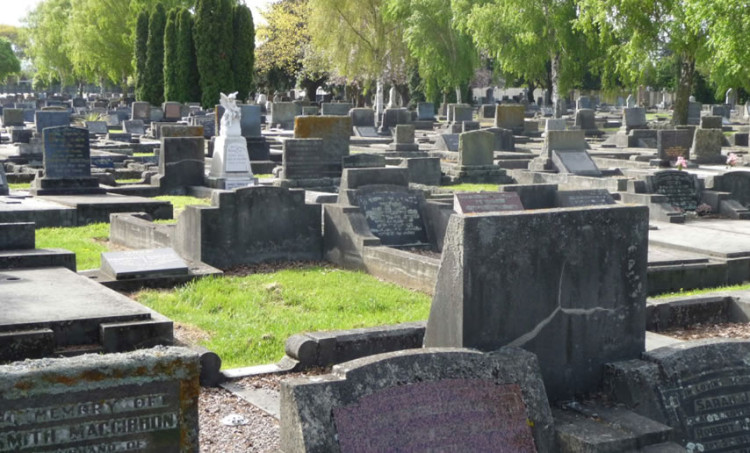
Waimairi Cemetery
Exclusive Right of Burial
The Council charges a fee for the purchase of an Exclusive Right of Burial for an ashes or burial plot. This fee only relates to the purchase of the burial right. Other fees will be payable at the time of a burial or disinterment. The Council reserves the right to refuse to sell any plot as an Exclusive Right of Burial.
When the plot has been fully paid, a Certificate of Right of Burial will be given to the person named on the certificate (the owner), or the Funeral Director, on behalf of the owner.
An Exclusive Right of Burial is granted in perpetuity, but is subject to section 10(4) of the Burial and Cremation Act 1964, which provides that an Exclusive Right of Burial lapses if 60 years have passed without a burial taking place in the plot.
Purchase options
A purchase of an Exclusive Right of Burial can be made either immediately prior to a burial or, in some cases, in advance. Purchases in advance (or pre – purchases) may be possible at some cemeteries but may be subject to restrictions. In some cemeteries, the pre–purchase of plots may not be available.
Later use of an Exclusive Right of Burial
Under Section 10 of the Burial and Cremation Act 1964 the Council is able to require satisfactory evidence that the person for the time being appearing to it to be entitled as owner [of the Exclusive Right of Burial] has consented or would not object to the burial taking place therein.
The person named on the Certificate of Right of Burial is the person the Council considers is entitled as owner to determine who may be interred in the plot. The owner must give their approval by completing an application for interment form, and is the only person who may authorise the placement of a monument on the grave.
If the person named on the Certificate of Right of Burial is deceased the Council will make a decision, at its discretion, on who appears to be entitled as owner to give approval for a burial in the plot (generally this will be the immediate next of kin or the person acting on behalf of the deceased).
Refund of an Exclusive Right of Burial
The purchaser of an Exclusive Right of Burial who no longer requires the plot cannot sell the right to a third party. The purchaser of the Exclusive Right of Burial can apply for a refund of 50% of the current fee charged for the purchase of an Exclusive Right of Burial, if no burial has occurred. The Certificate of Right of Burial must be returned to the Council to receive a refund.
Transfer of the Exclusive Right of Burial
The person who owns the Exclusive Right of Burial for a plot can apply to the Cemeteries Team to transfer that right to another person, entity or charitable organisation.
The application is necessary to ensure that the cemetery records are correct and to issue the Certificate of Right of Burial in the name of the new owner. An administration fee will be charged for the transfer.
Allocation of plots
The Cemeteries Team has responsibility for allocating plots for interments, in agreement with the Sextons. Where a family wishes to obtain a plot in a particular area the request will be accommodated if possible, providing there is no conflict with the effective management of the cemetery.
The specific number of plots able to be purchased by an individual will change from time to time at the discretion of the Parks Unit, depending on the plot availability of the type of interment requested.
At the time of a burial, if available the adjacent plot will be offered to the family for purchase.
Council routinely puts a plot on hold while families decide on a purchase. This is often when a family is considering purchasing a plot immediately adjacent to a recent burial. While the plot is on hold Council is unable to sell the plot.
A plot can only be put on hold for a maximum of six months. If after six months the plot has not been paid in full the Council will release the hold on the plot.
Burial and ash plots available for purchase
All new full-size burial plots are now standardised at 1400mm x 2700mm. Some existing full burial plots in cemeteries are still 1200mm x 2700mm. If a larger plot is required, arrangements can be made at the time of booking and confirmed with the Cemeteries Team.
Plot sizes vary between cemeteries and between old and new areas. New standards allow for wider plot widths. Refer to Table 1 for available plot types, sizes, number of interments per plot, depth of interments and availability.
Figure 1 is an example of a standard 1400mm wide plot with a double interment and Figure 2 is an example of a standard 600mm wide ash plot which can hold up to four standard sized urns.

Duvauchelle Cemetery
Burial and ash plots available for purchase
| Plot type and size | Number of interments per plot | Depth of interment | Availability | Standard monument requirements |
|---|---|---|---|---|
|
Standard |
Single or double interment. Can also include ash urns |
Single: 1400mm Double: 1830mm Triple: 2500mm (Avonhead Park Cemetery only) |
Older areas of working cemeteries | Refer to Appendix B [PDF, 17 MB] |
|
Standard |
Single or double interment. Can also include ash urns |
Single: 1400mm Double: 1830mm |
Standard for all new plots | Refer to Appendix C |
|
Muslim |
Single interment | 1400mm | Memorial Park Cemetery | Refer to Appendix D |
|
Muslim |
Single interment | 1400mm | Memorial Park Cemetery | Refer to Appendix E |
|
Green |
Single interment | 1300mm |
Diamond Harbour Memorial Gardens Cemetery Yaldhurst Cemetery |
Not applicable |
|
Green |
Four biodegradable ash urns | 600mm | Yaldhurst Cemetery | Not applicable |
|
Ash |
Four standard ash urns | 600mm | Most open Council cemeteries | Refer to Appendix F |
|
Ash |
Eight standard ash urns | 600mm | Limited open Council cemeteries | Refer to Appendix F |
|
Infant and baby loss |
Single interment. Can also include ash urns |
1400mm | Older working cemeteries | Refer to Appendix F |
|
Infant and baby loss |
Single interment. Can also include ash urns | 1400mm | Belfast Cemetery children’s area | Refer to Appendix G |
|
Infant and baby loss |
Single interment. Can also include ash urns | 1400mm | Belfast Cemetery children’s area | Refer to Appendix H |
|
Infant and baby loss |
One standard ash urn | 600mm | Belfast Cemetery children’s area | Refer to standard monument requirements for Belfast Cemetery |
Notes:
- No animals, including birds or fish, either as ashes or as a body, may be interred, in a Council cemetery unless placed in a sealed casket with the deceased.
- If the plot is located within an area of a cemetery with specific monument requirement, such as a lawn area or recumbent concrete beam refer to section 6.3.2 for standard.
- The number of ash urns indicated above is based on a standard sized urn. If a non-standard sized urn is used, the Cemeteries team should be contacted for guidance on the number of interments that can be made into a specified plot.
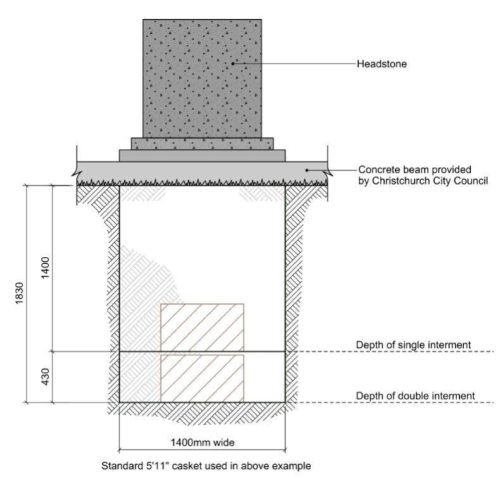
Figure 1 Standard 1400mm wide Burial Plot

Figure 2 Standard 600mm wide Ash Plot
Availability of plots in Christchurch City Council Cemeteries
This section outlines what types of plot are available for purchase in Council cemeteries. Second interments or interments in pre–purchased plots remain available at all open city cemeteries.
Bromley Cemetery, Lyttelton Anglican Cemetery and Lyttelton Catholic and Public Cemetery are all at capacity with no burial or ash plots available for purchase.
Plots are unable to be purchased in any closed Council cemetery including; Addington Cemetery, Akaroa French Cemetery, Barbadoes Street Cemetery, Mount Magdala Cemetery of the Good Shepherd Sisters and Rutherford Cemetery.
Second interments and ash interments are possible in certain circumstances within closed cemeteries as outlined in Section 42 (2) of the Burial and Cremation Act. Contact the Cemeteries Team in the first instance.
For availability of plots within the Banks Peninsula cemeteries, particularly for ash plots or infant plots if not listed as available, contact the Cemeteries Team for availability.
| Cemetery | Availability of plots |
|---|---|
| Avonhead Park Cemetery |
In the lawn area where only granite or bronze plaques laid flat below ground level are allowed:
|
|
Belfast Cemetery |
|
|
Diamond Harbour Memorial Gardens Cemetery |
No pre-purchasing is available at this cemetery for any plot:
|
|
Duvauchelle Cemetery |
|
| Kaituna Valley Cemetery |
|
| Le Bons Bay Cemetery |
|
| Linwood Cemetery |
Within the Jewish Area only:
|
|
Little River Cemetery |
|
|
Memorial Park Cemetery |
|
|
Pigeon Bay Cemetery |
|
|
Ruru Lawn Cemetery |
|
|
Sydenham Cemetery |
|
|
Waimairi Cemetery |
|
| Wainui Cemetery |
|
|
Yaldhurst Cemetery |
|
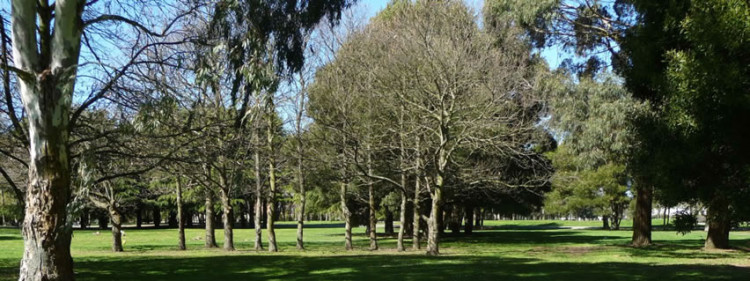
Avonhead Park Cemetery Lawn Area
No interments can take place in any cemetery owned, managed or maintained by the Council unless permission has been obtained from the Cemeteries Team. The appropriate fee must be paid prior to the burial taking place, and the Application for Interment form obtained from and lodged with the Cemeteries Team by the Funeral Director or person organising the interment.
Hours for interments
- Monday to Friday between the hours of 9am and 4pm.
- Saturday between the hours of 9am and 1pm.
The expected time of arrival at the cemetery is to be provided on the Application for Interment form. If the expected arrival time is going to change by more than 15 minutes of the original notified time the Cemeteries Team or Sexton must be notified of the new time.
No interments will be scheduled after 4pm Monday to Friday or 1pm, Saturday or Sunday unless in exceptional circumstances and only with the prior approval of the Cemeteries Team or Sexton (extra fees will apply). Interments will only be accepted on the hour and at 30 minutes past the hour.
Where an interment continues after 4pm on weekdays or 1pm on a Saturday, a late fee will be charged to the Funeral Director or person organising the interment.
A Saturday or Public Holiday fee will be charged for interments, if a Sexton is attending including ash interments, taking place on a weekend or Public Holiday. An interment can occur on a Sunday or Public Holiday with the prior approval of the Manager Community Parks and payment of all applicable fees.
No interments will be scheduled on Christmas Day, Good Friday or Anzac Day.
Where Boxing Day and 2nd January fall on a Sunday and are observed on a Tuesday, an interment can take place on the Tuesday between 9am and 1pm, at the discretion of the Cemeteries Team.
Interment procedures and requirements
Only a Sexton or person authorised by the Council is permitted to prepare a plot for the burial of human remains, or ashes of human remains, in a Council cemetery.
All equipment for interments is supplied and removed by the Sextons ensuring all safety procedures are complied with.
If required a testing service is available at no cost to determine the availability of sufficient space for a second interment in an existing grave.
A body interred in a shroud must be placed on a board for interment. The body is to be firmly fastened to the board to prevent movement of the body when transferring and lowering.
Plots with concrete covers
Where a second or subsequent interment is to take place within a grave with a concrete cover or surround, only an approved Council Contractor is permitted to break the concrete. The Cemeteries Team can provide a list of approved contractors.
Any costs associated with breaking the concrete and reinstating the concrete cover or surround is the responsibility of the owner of the Exclusive Right of Burial. All work must comply with all the monumental specifications for the particular cemetery.
Poor person burial
The Burial and Cremation Act 1964 requires the Council to bury the bodies of poor persons and persons from any hospital, prison, or other public institution on the request of the person in charge of such institutions, free of charge upon an order from a Justice of the Peace. An Application for Interment form must still be completed before the interment takes place.
No monuments or crosses are permitted on a poor person’s grave as the Exclusive Right of Burial has not been purchased.
If a family wishes to erect a monument on a poor person’s grave this can be facilitated when all the cemetery fees and charges have been paid at the current rate. The Council will then issue a Certificate of Right of Burial, which entitles the person to apply for a Monumental Work Permit. After 60 years the fee for a right of burial is waived so a monument may be placed on the grave.
Poor person burial in a family plot
If the burial of a poor person is requested to be in a plot where the Exclusive Right of Burial is owned by someone other than the Council, (for example a family member or friend), the burial of the poor person will only be permitted if the Right of Burial holder agrees that no future monumental work or burials may take place in that plot until all burial fees and charges have been paid at the current rate.
Ash interments
Only a Sexton or person authorised by the Council is permitted to prepare a plot for the interment of ashes in a Council cemetery.
Once an Application for Interment has been accepted and the interment has been booked by the Cemeteries Team, the plot will be prepared for the ashes to be interred. As part of the preparation, the plot will be covered by a board to make the site safe prior to the interment. The next working day following interment the plot will be checked and remedied if necessary.
After the plot has been prepared the family or Funeral Director will inter the ashes in the plot, filling the plot back to ground level.
The family or Funeral Director may elect for the Council to fill the plot, this must be indicated on the Application for Interment. If the Council is needed to fill the plot on a Saturday then an additional fee will be charged.
If more than one set of ashes are to be interred at the same time in the same plot then an application for interment must be received for each set of ashes. Only one plot preparation fee will be charged for the interment of two or more sets of ashes in the same plot at the same time. This only applies if standard-sized ashes urns are used or if the ashes alone are to be interred. The Cemeteries Team should be contacted if a non-standard-sized urn is to be used.
The last booking for an ash interment is 12:30pm on a Saturday as the preparation of plots for ashes will not be permitted after 1pm on a Saturday. The family may arrive later or even on the Sunday to inter the ashes, provided this is indicated on the Application for Interment and has been approved by the Cemeteries Team.
Scattering of ashes
The scattering of ashes is not permitted in any Council cemetery. In future the Council may set aside areas for ash scattering.
Specific interments
Council provides for the requirements of different religions and cultures. Contact the Cemeteries Team for particular information.
Special procedures for Māori interments
The Council recognises, and provides for, the spiritual and cultural values of Māori regarding the departure of mate (dead people). This includes the choice to select a plot of significance to them, such as having the headstone face north, the availability of water at the cemetery, the opportunity for Māori to fill in the grave and to have a ceremony to unveil the headstone, if desired.
Infant and baby loss interments
Infant burials (up to 7 years of age) are available in many Council cemeteries. An infant can also be buried in either a quarter plot or a standard burial plot.
A new Infant and Baby Loss area is available at Belfast Cemetery. The area includes a Baby Loss Memorial area and interment options for burial and ash interments. The Baby Loss area can be used for still births (post 20 weeks or 400g) and any baby loss from a miscarriage (pre-20 weeks) to a Neonatal Death (28 days). Please contact the Cemeteries Team for more information and guidance.
Natural burials and green burials
More environmentally friendly burial options, often referred to as Natural Burials, Eco Burials or Green Burials are all concepts based on a desire to reduce the long-term impact on the environment and return the body to the earth in a way which hastens the decomposition process and provides nutrients for a native tree or plant.
Green burials
With no Natural Burial / Eco Burial area in Christchurch, two areas within working Council Cemeteries have been established at Diamond Harbour Memorial Gardens Cemetery and Yaldhurst Cemetery which Council is referring to as Green Burials.
Green Burials are very similar in many ways to Natural Burials, however the locations within working Council cemeteries will limit the extent of long-term ecological restoration, but will enable easier and long term access to plots.
Green burials requirements
- Can only be undertaken within designated areas within Council cemeteries.
- The next adjoining plot available will be allocated for use. Contact the Cemeteries Team for pre-purchase rules.
- Plots have a small area adjacent for the planting of a small tree instead of a monument in addition to planting on top of the grave.
- Interments to be single depth, only one casket in each plot with a minimum cover of 800mm.
- Caskets, coffins or body coverings must be biodegradable, made of untreated wood and not contain any chemical or substance that prevents the breakdown of the materials used.
- Caskets and coffin linings are to be biodegradable and not of synthetic fibre.
- Caskets, coffin handles and ornamentation are to be removed before burial (if not biodegradable).
- Body coverings or shrouds must be placed on a solid base of natural untreated timber for burial and firmly fastened to the base to prevent movement of the body when transferring and lowering. The fastening should be removed once lowered or be biodegradable.
- Body coverings or shrouds, including clothes, must be non–toxic and biodegradable including zips, buttons and any personal items or keepsakes to be buried with the body.
- Only natural artefacts can be buried with the body.
- At the time of interment caskets, coffins, body coverings or shrouds must not be leaking fluids or have an offensive smell.
- The body is not to be embalmed or contain any chemicals that would slow or prevent the natural breakdown of the body in the soil. Council may request documentation to confirm this.
- As with traditional burials, animals can be interred in Green Burial plots in the casket (if there is one) with the deceased at the time of burial. No ashes are to be interred in a Green Burial plot.
Ash interment requirements in a green burial area
- All plots are located within formed plant beds.
- The next adjoining plot available will be allocated for use. Contact the Cemeteries Team for pre-purchase rules.
- Any mulch on the plant bed is to be removed prior to plot preparation and replaced back when the interment is complete.
- Any container must be biodegradable or made of untreated wood and not contain any chemical or substance that prevents breakdown of the materials used.
- Only natural artefacts can be buried with the ashes.
Green burial memorials
- Memorials such as placing headstones on a Green Burial plot are not permitted.
- One untreated wooden marker per burial plot may be placed on the grave at the time of interment or within the first week. The marker must be no larger than 150mm 100mm in size and 250mm above ground level. The marker must be attached to an untreated timber stem a maximum size of 100mm x 100mm that can be pushed into the soil. The marker is to be centrally located at the head of the grave. The marker will be removed when the plot is planted.
- Two memorial seats have been provided in the Green Burial area at Diamond Harbour Memorial Gardens Cemetery, where one plaque per plot (100mm x 150mm maximum) can be installed.
Green burial planting
- Each Green Burial plot is allocated a small area at the head of each plot to allow for a large shrub or small tree to be planted if desired. Ash plots are located within existing plant beds so are not allocated this space, instead, planting must be within the plant bed either above the interment or immediately adjacent.
- The whole plot will be mulched and planted by Council the autumn following the interment.
- Council contractors will supply and plant the plants during a planting ceremony, where family and friends can participate and join in the planting.
- No planting is to be undertaken by anyone other than the Council or its contractors.
- If family and friends want to supply a particular plant/s, they would need approval of Council and would need to be planted during the planting ceremony.
Other environmentally friendly burial options
Burials at any operating cemetery may take place without embalming, but subject to all other rules applying to standard burials. No planting is permitted on top of the grave.
Family and friends of the deceased may remove non – biodegradable items prior to burial if they wish.
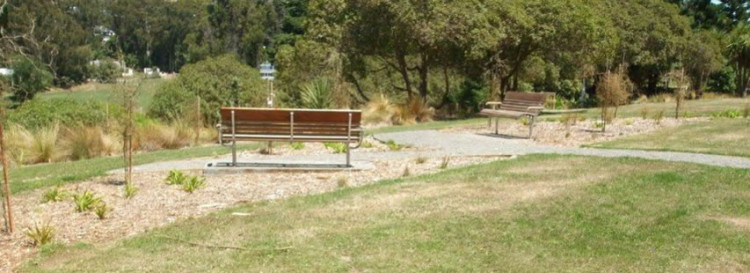
Diamond Harbour Memorial Gardens Cemetery Green Burial Area
Service areas
Applicable to Services areas within Bromley Cemetery, Ruru Lawn Cemetery, Diamond Harbour Memorial Gardens Cemetery and Lyttelton Catholic and Public Cemetery only.
Please be aware that the Cemeteries Team must verify that individuals qualify for a burial or ashes plot at no cost in these areas. Standard burial fees will apply.
Details of war service need to be supplied on the Application for Interment form, these include: branch of service, service number and dates of service. Failure to provide this information could result in the Application for Interment in a Services area being declined.
The Cemeteries Team need to receive this information as early in the process as is possible, as the information
needs to be forwarded to the New Zealand Defence Force Archives for service verification.
Specifications for service person’s interment
Only Service Personnel and their spouse or partner may be interred in the Service area.
The Service Person must be the first deceased to be buried.
Double-depth interments are permitted in the Service area to allow the spouse or partner of the deceased veteran to be interred in the same plot. A double plaque commemorating both deceased persons is provided at a subsidised rate.
Please note that all interments before 1988 are single depth and a second interment in these graves can only be ashes. After 1988 interments were double depth on request.
If the spouse or partner wishes to be interred to the side of the Service Person, they will have to pay the fee to purchase the burial right for the adjoining plot.
Children cannot be interred in a Service Person’s plot unless they are eligible for interment in the Service area in their own right.
The plot is allocated by the Cemeteries Team.
Service area monuments
If the interment of a deceased veteran is to be in a Service area, a standard ex-Service memorial either as a plaque or a headstone, depending on the type of cemetery, is available at a subsidised rate through Veterans’ Affairs New Zealand. In a Service area only the standard ex-Service memorial is permitted. The memorials are of a uniform style and there is no provision for personal messages or photographs.
If the interment is to be in a public cemetery (but not within the Service area), the next of kin can order a standard ex-Service memorial, either a plaque or headstone, at a subsidised rate.
War service eligibility and contacts
Please refer to the Veterans’ Affairs New Zealand website for eligibility: www.veteransaffairs.mil.nz (external link)
Application for an Ex-Service Memorial. Please apply to:
Veterans’ Affairs New Zealand
PO Box 5146
Wellington 6140
Free phone (NZ): 0800 483 8372.
International callers phone: +64 4 495 2070 (international toll charges will apply).
Email: veterans@nzdf.mil.nz.
For copies of Service records please refer to New Zealand Defence Force Archives(external link).
Avonhead Park Cemetery interment site
For the victims of the 22nd February 2011 Christchurch earthquake.
Inner Interment Circle
The Inner Interment Circle is reserved for the four unfound victims and their spouses or partners. The spouse or partner may be interred in the same plot. Only one recumbent granite plaque per person may be attached to the existing bluestone recumbent.
No immediate family (including children) may be interred in this plot. An ash plot can be purchased on the outer circle for immediate family members (children/parents /grandparents).
Outer Interment Circle – Blocks 2A and 3A
The Outer Interment Circle has 600mm x 600mm plots available for the ash interment of all victims of the Christchurch Earthquake and their spouse, partner, parents, children or grandparents. Each plot can hold four ash interments only and one upright or recumbent headstone.
Both the victim and their family may have their names engraved on the headstone.
Only the immediate family (spouse, partner, parents, children or grandparents) of earthquake victims may purchase plot/s in this area.
There is provision to purchase a plot to install a headstone without actually interring ashes. This may be the case if victims are buried in other locations, but the family would still like to be part of the interment site.

Avonhead Park Cemetery Earthquake Interment Site
Caskets
For health and safety reasons any casket that exceeds 400mm in depth will only be interred at single depth.
If an interment involves a couch style casket this must be notified on the Application for Interment form as these caskets will only be interred at single depth.
The casket size and shape, including the type and size of the handles are to be recorded on the Application for Interment. The Council retains the right to determine the definition of a suitable casket.
Shoring boards
When prepared, plots must be shored for safety reasons. The shoring boards will be removed at the conclusion of the interment unless the family or friends wish to hand fill the grave. A request to hand fill a grave must be made on the Application for Interment form.
Request to fill a grave
There are two options available to families or friends in relation to filling a grave following an interment:
- A partial fill - where the casket is covered only. No heavy machinery is required to remove the shoring boards, or
- A complete fill - where the whole plot is filled. If this option is requested, the Sexton will be required to remove the shoring boards with the appropriate equipment to allow the grave to be filled. The directions of the Sexton during this process must be followed. A lowering device cannot be used if family or friends elect to fill the grave.
Site safety during a burial
The Funeral Director is to advise the Sexton upon arrival at the Cemetery, and the site will be handed over to the Funeral Director. The Funeral Director is then responsible for the safety of the members of the public at the grave site until the Funeral Director formally hands the site back to the Sexton after the public have left the cemetery.
If there is no Funeral Director controlling a burial then the site safety remains in the care of the Sexton and members of the public must follow the direction of the Sexton.
Vehicles
Except for a hearse or Council authorised vehicle, vehicles are only permitted within cemeteries on marked roadways or any open area clearly designated for vehicles. The indicated speed limit and traffic rules are to be observed at all times. The Traffic and Parking Bylaw 2017 applies.
Private vehicles can only be taken into cemeteries for cemetery purposes such as attending burials or visiting a grave.
The drivers of all vehicles must yield right of way to any funeral procession (cortege) in any cemetery.
If the Sexton indicates that a vehicle should stop or move, the driver must respond as directed.
No long term parking of any vehicle (including when the cemetery is closed) or inappropriate or insensitive activities such as vehicle maintenance or cleaning can be undertaken in any cemetery.
Advertising and soliciting of custom
No advertising or soliciting for custom is permitted in any cemetery.
Photography or filming
Only filming and photography for private use is permitted.
No one, without the written consent of the Council and the consent of the family, may take photographs or television footage for any media purpose. No commercial filming (television footage) or photography is permitted in any cemetery without prior permission.
Visiting
The Cemeteries Team are to be advised of any unveiling ceremony, to ensure it can be undertaken without disturbing cemetery activities or burials.
Any organised group or tour visit of any cemetery should be confirmed with the Cemeteries Team to ensure it doesn’t impact on cemetery activities or burials.
Control of dogs and animals within cemeteries
These provisions are found in the Christchurch City Council Dog Control Bylaw 2016 and the Christchurch City Council Parks and Reserves Bylaw 2025:
Any person taking a dog into a cemetery shall keep the dog on a leash and under effective control at all times.
Misconduct
No one may disturb or interrupt a funeral, or ceremony, or cause annoyance or nuisance within a Council cemetery, or cause damage to land, buildings or chattels within a Council cemetery.
Offence and penalty
Every person who breaches the Christchurch City Council Cemeteries Bylaw commits an offence and is liable to summary conviction to a fine not exceeding $20,000 as set out in the Local Government Act 2002.

Memorial Park Cemetery
Monumental work
The owner of the Exclusive Right of Burial must give permission for a monument to be erected on a plot, or for wording to be added to an existing monument. If the owner is unable to do this, the immediate next of kin or the owner’s representative must give permission.
A Monumental Work Permit is required for any monumental work, including alterations or modifications to concrete covers or kerbs, being undertaken in a Council cemetery. The approved contractor for monumental work applies for the permit on behalf of the owner of the Exclusive Right of Burial or their representative.
Any monumental work in heritage cemeteries or on any plot with a burial or monument prior to 1950 will be subject to specific requirements. Refer to 6.4.
Only an approved contractor for monumental work may undertake work associated with any monument (including concrete kerbing or covering) in a Council cemetery. All documentation including the Monumental Work Permit must be available for inspection by the Council or their representative at any time.
Details on how to become an approved contractor or for a list of approved contractors for monumental work please contact the Cemeteries Team.
No person (approved contractor for monumental work, family or other) may remove from any plot, any kerb or monument unless they have permission from the Cemeteries Team.
Refer to Veterans Affairs New Zealand for any monument requirements or modifications within any Service area in a Council cemetery.
Installation of monuments
All monuments including headstones and plaques are to be constructed and installed as per the Council Monument Specifications in Appendix B to H [PDF, 17 MB] and as per the Proposed NZS 4242: 2018 Headstones and Cemetery Monuments. Where there are any discrepancies, Council Specifications take precedence.
Where appropriate, Council will provide concrete beams for headstones to be installed on. The cost of the concrete beam is included in the purchase price of the Exclusive Right of Burial.
Where there is no concrete beam the monument size specifications for the plot are to be adhered to. Council Monument Specifications are to be followed.
Concrete covers
Where remediation work, or a second or subsequent interment is to take place within a grave with a concrete cover or surround, only an approved Council contractor is permitted to break the concrete.
Contact the Cemeteries Team for further information and if necessary to confirm whether a concrete cover and surround is permitted, or whether it is necessary to cut into an existing concrete cover and surround for a burial to take place.
In the older area of Yaldhurst Cemetery (Block ‘O’) there are a limited number of plots where concrete kerbing and covering is permitted.
Any costs involved with breaking the concrete and reinstating the concrete cover or surround is the responsibility of the owner of the Exclusive Right of Burial and must comply with all monumental specifications for the particular cemetery.
No kerb or fence, covering or other structure is permitted, other than to replace an existing permitted structure.
Monument requirements and particular specifications
A monument must be made of granite, bronze or other non–ferrous metal, or similar suitable material approved by the Cemeteries Team prior to the installation of the monument. No stainless steel, schist, sandstone, limestone, marble, wood, fibreglass, ceramic, plastic, glass or other unsuitable material as determined by the Cemeteries Team is allowed.
No concrete work is to be painted or colour tinted.
No photographs, text or images of any description (letters, symbols and drawings) are permitted on the reverse side of any monument.
Company names are only permitted if discreetly placed at the bottom of the front of a monument.
General monument requirements
There are standard monument specifications used across the Council cemeteries. The monument requirements are the same whether there is a concrete beam provided or not.
1200mm wide full burial plot – Refer to Appendix B for detail:
- Monument Base: 1200mm x 500mm maximum
- Monument Height: 1200mm maximum
1400mm wide full burial plot – Refer to Appendix C for detail:
- Monument Base: 1400mm x 500mm maximum
- Monument Height: 1200mm maximum
1500mm wide Muslim full burial plot – Refer to Appendix D for detail:
- Monument Base: 1500mm x 500mm maximum
- Monument Height: 1200mm maximum
600mm wide ash plot, infant plot, quarter plot or baby loss plot – Refer to Appendix F and G for detail:
- Monument Base: 600mm x 500mm maximum
- Monument Height: 750mm maximum
750mm wide infant plot or Muslim infant plot – Refer to Appendix E and G for detail:
- Monument Base: 750mm x 500mm maximum
- Monument Height: 750mm maximum
Specific monument requirements
There are a number of Council cemeteries with monument specifications which differ to the general monument requirements as outlined in Section 6.3.1 and Appendix B to H [PDF, 17 MB]. The following cemeteries have particular monument specifications.
Akaroa Anglican Cemetery:
- Type: Recumbent concrete beam
- Monument Specification: Granite or bronze plaque 500mm x 250mm maximum
Avonhead Park Cemetery:
- Area: Lawn (Full burial and ash plots)
- Monument Specification: Granite or bronze plaque 290mm x 200mm maximum
- Plaque must be laid flat 20mm below ground level
- Plaster or stainless steel surround is optional
- Area: Interment Site for the Victims of the 22nd February 2011 Christchurch Earthquake – Bluestone
- Recumbent (inner circle – for spouse or partner only)
- Monument Specification: Black granite plaque 400mm x 250mm to be attached to the recumbent
- Area: Interment Site for the Victims of the 22nd February 2011 Christchurch Earthquake – Concrete beam
- 600mm wide ash plots (outer circle – for all victims and their families)
- Monument Specification: Memorial or recumbent headstone
- Base 600mm x 500mm maximum, height 750mm maximum
Belfast Cemetery:
- Type: Recumbent baby loss beam
- Monument Specification: Bronze plaque 150mm x 100mm maximum
Diamond Harbour Memorial Gardens Cemetery:
- Type: Recumbent concrete beam (ash beam)
- Monument Specification: Granite or bronze panel 550mm x 450mm maximum
Le Bons Bay Cemetery:
- Type: Wooden gate with plaques
- Monument Specification: Bronze plaque 150mm x 100mm
Ruru Lawn Cemetery:
All plots in Ruru Lawn Cemetery are in lawn areas. All monuments placed either on beams provided by Council or on lawn areas are to be laid flat 20mm below ground level. Plaster or stainless steel surround is optional.
- Burial type: 1200mm wide burial plots
- Monument Specification: Granite or bronze plaque - 600mm x 400mm maximum
- Burial type: 600mm wide ash plots and quarter plots
- Monument Specification: Granite or bronze plaque - 400mm x 250mm maximum
- Area: Recumbent concrete ash beam
- Monument Specification: Granite or bronze plaque - 300mm x 150mm maximum
Sydenham Cemetery:
- Area: Raised ash plots (plant bed edge)
- Monument Specification: Granite or bronze plaque - 300mm x 150mm maximum
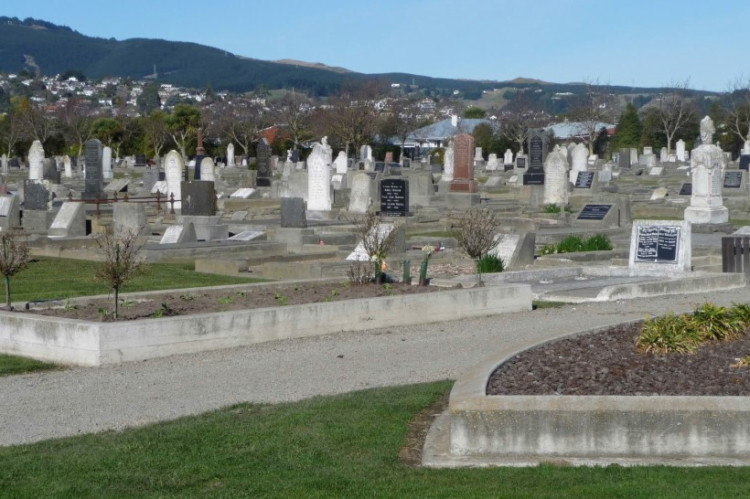
Sydenham Cemetery
Monumental work in heritage cemeteries or on any plot with a burial or monument prior to 1950
The following Cemeteries are Heritage Cemeteries: Addington Cemetery, Akaroa French Cemetery, Barbadoes Street Cemetery, Rutherford Cemetery and Mount Magdala Cemetery of the Good Shepherd Sisters. Addington Cemetery and Barbadoes Street Cemetery have Conservation Plans that provide Conservation Policies to guide the work undertaken in these cemeteries.
For any monumental work in heritage cemeteries or on any plot with a burial or monument prior to 1950 please contact the Cemeteries Team.
In addition to the Monumental Work Permit additional forms may need to be provided including:
- Application for the installation of a new monument in a heritage cemetery.
- Application for work in a heritage cemetery.
There is a Global Resource Consent (RMA92028348) for maintenance and repair works on headstones and other structures and alterations to Barbadoes Street Cemetery, Addington Cemetery and Rutherford Cemetery. The consent covers: graffiti removal, landscape management and maintenance, addition of new monuments and repair of grave markers.
Once applications have been received for any monumental work in heritage cemeteries or on any plot with a burial or monument prior to 1950, Council will notify the applicant if the Global Resource Consent can be used. If it can, a permit will be issued and conditions to be met will be provided to the applicant. If work is not permitted under the Global Resource Consent the applicant may be required to apply for a separate Resource Consent.
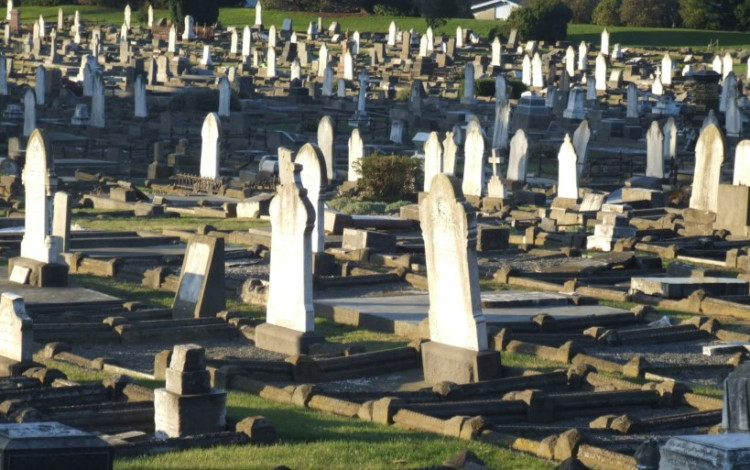
Linwood Cemetery
New vaults or mausolea
The Council does not allow the construction of new vaults or mausolea in any Council cemetery.
Existing vaults
Vault owners or their representatives, must keep the vault in proper order and repair. If a vault falls into disrepair, the Cemeteries Team may give the owner of the vault (or their representatives) six month’s written notice to repair the vault. If the above persons fail to do the required repairs within six months, the Council may do all or any of the following:
- Prohibit any further interment in the vault until the repairs have been made.
- Carry out the repairs or any conservation work itself.
- Recover the cost of any repairs or conservation work from the owner of the vault, or their representatives as a debt.
If an owner of a vault wishes to undertake any work on an existing vault, please contact the Cemeteries Team.
All existing vaults must be fully lined with masonry concrete or stone set in cement, mortar or other approved material. The entrance to the vault must be sealed and have secure fastenings maintained to the satisfaction of the Council.
A key for an existing vault is to be held by the Sexton.
Coffins for vaults must be lined with lead or other approved material, and securely sealed. Coffins not lined may be laid in vaults and completely encased in cemetery, concrete or other approved material.

Bromley Cemetery
Monument maintenance
Maintenance of monuments (including concrete kerbing or coverings) is the responsibility of the owner of the Exclusive Right of Burial or their representative.
Monuments must be kept in good repair. The Council does not take any responsibility for damage or vandalism to any monument.
The Council may remove from the cemetery any monuments that have fallen into a state of disrepair. If the Sexton or Cemeteries Team determine that a monument is an extreme health and safety risk, the Cemeteries Team may give the owner of the plot or their representative three months' written notice to repair or remove the item in disrepair. Failure to comply with the notice will result in the monument being removed at the cost of the owner or their representative.
If a monument is unsafe or is a health and safety risk and there is no owner or representative available to effect repairs or permit removal, the monument will be laid flat within the grave surround or removed from the cemetery if there is no grave surround. A photographic record of the monument will be taken and filed with cemetery records if the monument is removed.
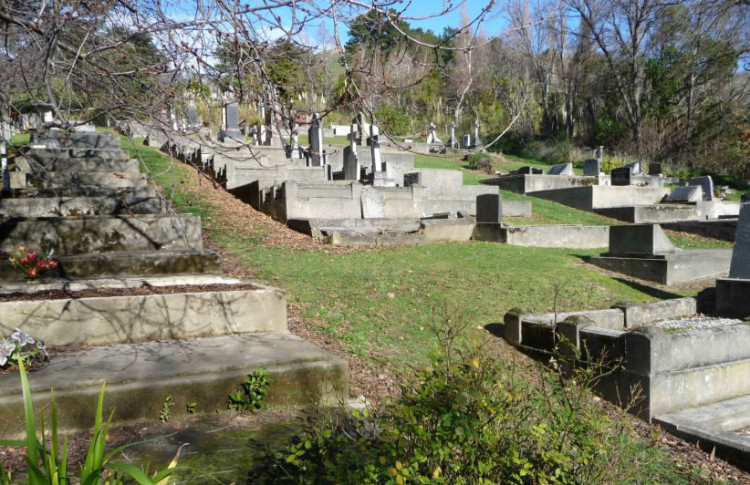
Akaroa Catholic Cemetery
Adornments
Wreaths, food items and other floral tributes or ornaments not permanently fixed to the monument may be placed on the plot for a period of ten days following the interment. After ten days items must be removed or relocated to the concrete beam or area around the headstone.
The Council may remove unapproved receptacles, ornaments or other tributes at any time to facilitate the maintenance of plots.
Any adornments that encroach on the mowing strip and obstruct or impede burials, grass maintenance or other cemetery operations will be removed.
Family or friends may remove or take from any grave items placed there, such as a wreath, plants or flowers. The Council may remove any neglected or broken items.
If there is an approved concrete kerb around the grave the inner area may contain tributes providing they do not cause hazards, safety or maintenance issues and are not considered offensive to visitors or families of neighbouring graves.
No ceremonial fires are permitted.
Full adornment of plots
Full adornments of plots such as grave gardens or other structures on the lawn area of a plot, either of a permanent or temporary nature are not allowed in any cemetery as they obstruct and impede the operation and maintenance of the cemetery. The Council will remove any such adornments without notice if necessary to facilitate a burial or if they are deemed a health and safety risk.
Where possible, prior to removal, the Council will attempt to contact the plot owner and request the owner remove such adornments. If the Council is unable to contact the plot owner or after making contact the owner has not complied with the request, the Council will remove the adornments and hold them for a period of 30 days, after which they will be disposed of. The owner of the plot will be charged for any removal costs, disposal fees and any plot remediation costs incurred by Council.
Temporary markers
White crosses or temporary markers are permitted in cemeteries for one year following an interment.
A temporary marker must be removed once a permanent monument is erected.
If the Council considers that a temporary marker has fallen into a state of disrepair the Council may remove it.
Standard plots
The Council maintains plots and graves in lawn areas including mowing.
No plants are to be planted on any grave other than in a designated Green Burial area.
Any plants (including trees and shrubs) planted on a grave following an interment will be removed after ten days and the area sown with grass seed. The grave will be maintained as lawn.
Green burial plots
In a designated Green Burial area all planting on graves will be undertaken and maintained by the Council.
Pre 1950’s plots
For maintenance on any plot with a burial or monument prior to 1950 refer to section 6.4.
Plots with concrete kerbing
No new plants are to be planted on graves. Existing plants (under 1000mm high at maturity) may remain providing family or friends maintain them. If any plants are not being maintained the Council will remove them. If appropriate the exposed surface will be covered with chip.
Graves must be kept free of weeds at all times. If there are no plants, concrete or chip covering on a plot and weeds become a problem the Council will remove them. The exposed surface will then be covered with chip.
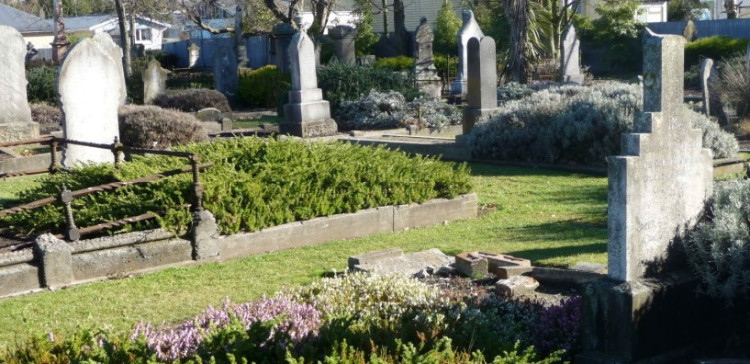
Addington Cemetery
Genealogical information and information about the historic Barbadoes Street Cemetery, Addington Cemetery and Rutherford Cemetery is available from the Central Library, and the Christchurch City Council archives.
The cemetery database is available on the Council website.
If the Cemeteries Team is approached to source genealogical information, the applicant may be requested to pay a fee for the search as per the Council’s schedule of fees.
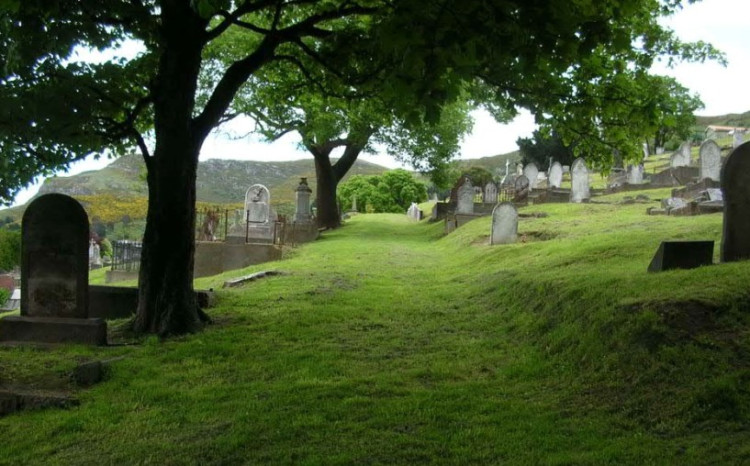
Lyttelton Anglican Cemetery
